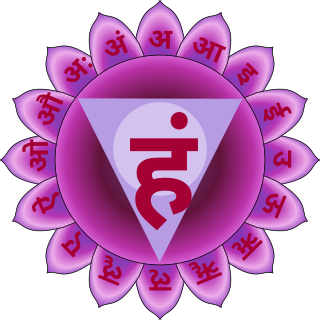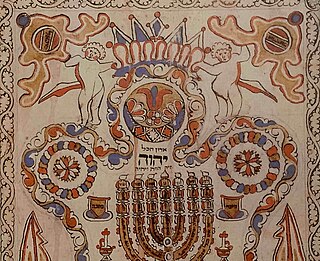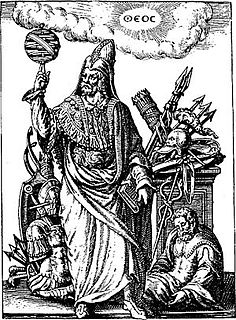
The tree of life is a term mentioned in the Hebrew Bible.

Vishuddha, or Vishuddhi, or throat chakra is the fifth primary chakra according to the Hindu tradition of tantra. Endocrine: Thyroid. The residing deity of this chakra is Panchavaktra shiva, with 5 heads and 4 arms, and the Shakti is Shakini.

A torsion spring is a spring that works by twisting its end along its axis; that is, a flexible elastic object that stores mechanical energy when it is twisted. When it is twisted, it exerts a torque in the opposite direction, proportional to the amount (angle) it is twisted. There are various types:

Tzadik is a title in Judaism given to people considered righteous, such as Biblical figures and later spiritual masters. The root of the word ṣadiq, is ṣ-d-q, which means "justice" or "righteousness". When applied to a righteous woman, the term is inflected as tzadeikes/tzaddeket.

Keter also known as Kether, is the topmost of the sephirot of the Tree of Life in Kabbalah. Since its meaning is "crown", it is interpreted as both the "topmost" of the Sephirot and the "regal crown" of the Sephirot. It is between Chokhmah and Binah and it sits above Tiferet. It is usually given three paths, to Chokhmah, Tiferet and Binah.

Sefirot, meaning emanations, are the 10 attributes/emanations in Kabbalah, through which Ein Sof reveals Himself and continuously creates both the physical realm and the chain of higher metaphysical realms. The term is alternatively transliterated into English as sephirot/sephiroth, singular sefirah/sephirah etc.

Ein Sof, or Eyn Sof, in Kabbalah, is understood as God prior to any self-manifestation in the production of any spiritual realm, probably derived from Solomon ibn Gabirol's term, "the Endless One". Ein Sof may be translated as "unending", "(there is) no end", or infinity. It was first used by Azriel, who, sharing the Neoplatonic belief that God can have no desire, thought, word, or action, emphasized by it the negation of any attribute. Of the Ein Sof, nothing ("Ein") can be grasped ("Sof"-limitation). It is the origin of the Ohr Ein Sof, the "Infinite Light" of paradoxical divine self-knowledge, nullified within the Ein Sof prior to creation. In Lurianic Kabbalah, the first act of creation, the Tzimtzum self "withdrawal" of God to create an "empty space", takes place from there. In Hasidic Judaism, the Tzimtzum is only the illusionary concealment of the Ohr Ein Sof, giving rise to monistic panentheism. Consequently, Hasidism focuses on the Atzmus divine essence, rooted higher within the Godhead than the Ein Sof, which is limited to infinitude, and reflected in the essence (etzem) of the Torah and the soul.

Binah, is the third sephira on the kabbalistic Tree of Life. It sits on the level below Keter, across from Chokhmah and directly above Gevurah. It is usually given four paths: to Keter, Chokhmah, Gevurah, and Tiphereth

Gevurah or geburah (גבורה), strength, is the fifth sephirah in the kabbalistic tree of life, and it is the second of the emotive attributes of the sephirot. It sits below Binah, across from Chesed, and above Hod.

Tiferet alternatively Tifaret, Tifereth, Tyfereth or Tiphereth, is the sixth sefira in the kabbalistic Tree of Life. It has the common association of "Spirituality", "Balance", "Integration", "Beauty", "Miracles", and "Compassion".

Yetzirah is the third of four worlds in the Kabbalistic Tree of Life, following Atziluth and Beri'ah and preceding Assiah. It is known as the "World of Formation".

Yesod is a sephirah or node in the kabbalistic Tree of Life, a system of Jewish philosophy. Yesod, located near the base of the Tree, is the sephirah below Hod and Netzach, and above Malkuth. It is seen as a vehicle allowing movement from one thing or condition to another. Yesod, Kabbalah, & the Tree of Life are Jewish concepts adopted by various philosophical systems including Christianity, New Age Eastern-based mysticism, and Western esoteric practices.

Federalist No. 51, titled: "The Structure of the Government Must Furnish the Proper Checks and Balances Between the Different Departments", is an essay by James Madison, the fifty-first of The Federalist Papers. This document was published on February 8, 1788, under the pseudonym Publius, the name under which all The Federalist papers were published. Federalist No. 51 addresses means by which appropriate checks and balances can be created in government and also advocates a separation of powers within the national government. This idea of checks and balances became a crucial document in the establishment of the modern U.S. system of checks and balances. One of its most important ideas, an explanation of check and balances, is the often-quoted phrase, "Ambition must be made to counteract ambition."
Thaumiel is the name of one of the Qliphoth in the Kabbalah, the shadow side of the Kabbalistic Tree of Life. It is the shadow of the Sephirah Keter. While Keter is concerned with the unity of God, Thaumiel represents the dual contending forces, struggling, and it is represented by two giant heads with bat-like wings.
Golachab is the Qliphah corresponding to the Sephirah Geburah on the kabbalistic tree of life. Its name means the ‘Burners with Fire’, and the image of the demons associated with it are of enormous black heads like a volcano in eruption.

Ze`ir Anpin is a revealed aspect of God in Kabbalah, comprising the emotional sephirot attributes: Chesed, Gevurah, Tiphereth, Netzach, Hod and Yesod.

Lurianic Kabbalah is a school of kabbalah named after the Jewish rabbi who developed it, Isaac Luria. Lurianic Kabbalah gave a seminal new account of Kabbalistic thought that its followers synthesised with, and read into, the earlier Kabbalah of the Zohar that had disseminated in Medieval circles.

Hermetic Qabalah is a Western esoteric tradition involving mysticism and the occult. It is the underlying philosophy and framework for magical societies such as the Golden Dawn, Thelemic orders, mystical-religious societies such as the Builders of the Adytum and the Fellowship of the Rosy Cross, and is a precursor to the Neopagan, Wiccan and New Age movements. The Hermetic Qabalah is the basis for Qliphothic Qabala as studied by left hand path orders, such as the Typhonian Order.

Olam HaTohu and Olam HaTikun are two general stages in Jewish Kabbalah, in the order of descending spiritual Worlds (Olamot). In subsequent creation they also represent two archetypal spiritual states of being and consciousness. Their concepts derive from the new scheme of Lurianic Kabbalah by Isaac Luria (1534–1572), the father of modern Kabbalah, based on his interpretation of classic references in the Zohar.









